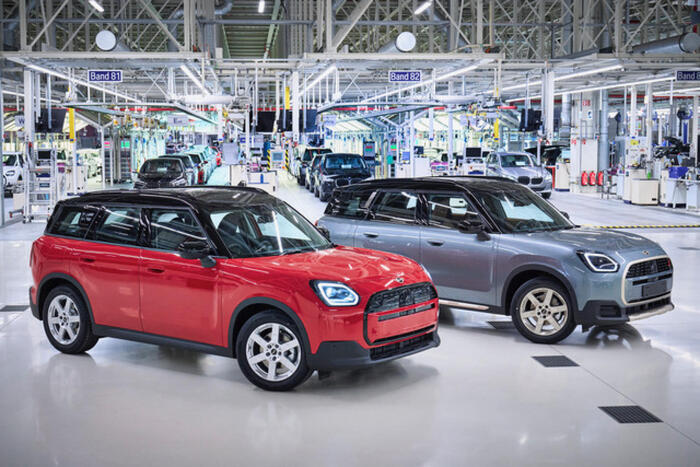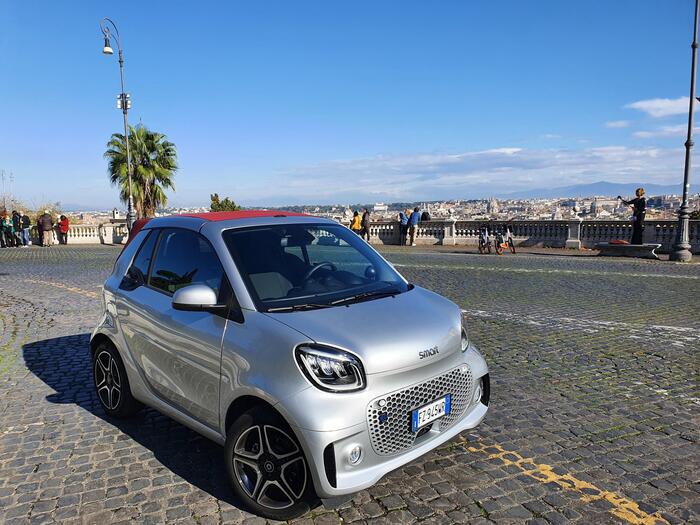Enlarge image
Lightyear Zero: Five square meters of solar cells on the body
Photo: Lightyear
Lex Hoefsloot relies on symbolism.
That's why the lanky Dutchman has invited to the maiden voyage with his Lightyear Zero at the end of June.
After all, the sun is no longer in the sky at any time of the year, even in Tudela in the hot northern Spanish highlands.
And sunshine is as essential for Hoefsloot as petrol and diesel are for classic car bosses.
Ever since the Dutchman won the Solar World Challenge across Australia as a student with fellow students from Eindhoven University in 2013, he has been dreaming of green mobility powered by the sun's rays.
Hoefsloot is now 31 years old, has been the company boss since 2016 and five colleagues have become 500.
His dream is set to come true later this year with the delivery of the Lightyear Zero.
Then the five meter long, flat vehicle will become the first solar car in series production.
In the best case, it supposedly only has to go to the charging station after more than 1000 kilometers.
The Dutch are not alone in their longing for clean solar power for the electric car of the future.
In Munich, the start-up Sono is trying to bring its small car Sion onto the market.
Established large-scale manufacturers are also experimenting with this technology, says Martin Heinrich from the Fraunhofer Institute for Solar Energy Systems (ISE) in Freiburg.
Hyundai, Kia and Genesis have a solar panel at least as an option for the Ioniq5, EV6 and GV60, just like the Toyota Prius.
Mercedes also relies on photovoltaics for its efficiency miracle EQXX.
It looks suspiciously similar to the Lightyear.
With good reason, says Heinrich: "Solar energy can make an important contribution to the mobility turnaround." The expert doesn't just mean installations on garage or house roofs.
He calculates that an appropriately equipped car can cover an average of 2,000 kilometers a year in Freiburg.
Heinrich admits that it always has to be in the open air.
But even in the scenario for a shade or garage parker who only brings the car into the light to drive, the scientists still come up with 1200 kilometers under southern German conditions.
With an average annual mileage of 12,843 kilometers in 2021, that is still ten percent for which electricity comes from the sky free of charge.
Of course, solar cells are more effective on the roof of your home, aligned with the sun - especially since many more cells can be installed there, the Fraunhofer man concedes.
"But if we want to conserve fossil energy resources, we have to take green electricity where we can get it." In addition, not every driver has a garage or roof for a PV system.
So far, however, no one has gone as far as Hoefsloot and his Lightyear Zero comrades-in-arms.
The fact that it can cover a solar distance of 40 to 50 kilometers per day of use in summer, even under Dutch or northern German conditions, is partly due to the approximately five square meters of photovoltaic cells that Hoefsloot has glued to the bonnet, roof and tailgate.
But also because the Lightyear Zero is more efficient than most other electric cars.
Just getting as much energy as possible from the sky is not enough, says technical director Arjo van der Ham.
"For maximum range, we also need minimum consumption."
Many hundreds of solar cells
That's why he's at least as proud of the aerodynamic shape as he is of the hundreds of solar cells that replace the paint behind glass.
At 0.19, the Cd value (describes the aerodynamic slippage) of the Zero 1 is below that of the Mercedes EQS, which is praised in this discipline - thanks to ultra-narrow and fully clad wheels, closed wheel housings at the rear, cameras instead of mirrors and a small frontal area.
The weight of not even 1.6 tons undercuts even any conventional luxury sedan of this format, the electric versions anyway.
And with in-wheel motors that aren't installed anywhere else, the Zero's drive is more efficient than any other production car.
"That then allows for a smaller battery again. At 60 kW, we can afford significantly less charging power than most others, because we get more kilometers per minute from the socket with the low consumption.
Smaller tires, weaker brakes and, and, and, are enough for us,” von den Ham describes the spiral of disarmament.
Ultimately, this leads to a record-breaking consumption of 10.5 kWh per 100 kilometers.
For comparison: A VW ID3 is in the list at best with 13.5 kWh, a Mercedes EQS with 19.8 kWh and an Audi e-tron with 22 kWh.
Although the battery only holds 60 kWh, van der Ham promises a standard range of over 600 kilometers.
That doesn't even include solar power.
"If we consider that most people drive significantly less than 100 kilometers a day, the battery power is enough for a week, in which up to 50 kilometers of solar power are added each day," calculates the head of technology.
"You can drive more than 1000 kilometers before you actually have to recharge from the network."
And the slower you drive or the further south you go, the further you get: Although the sky was suddenly full of clouds during the maiden voyage in Spain, the Zero manages to walk at a better pace without a battery and, according to the vehicle information system, drives alone with the battery power of the sun.
However, you have to adjust a little when driving the Zero.
Even if the Zero competes with luxury liners such as the Lucid Air, the Model S, the i7 or the EQS at first glance, the Dutch are very cautious.
The space conditions may still be comparable, except that the seating position in the Zero is significantly lower and therefore more natural.
The on-board computer is perhaps even more informative because it gives more detailed information about the energy flow, shows the solar harvest to the second and colors the car on the screen more intensely yellow the more electricity the car draws from the sky.
But the interior is - vegan, leather-free and lined with rattan instead of root wood - much more sober.
And without gimmicks like huge screen landscapes, complex climate control systems and the well-known army of electrical helpers.
Incidentally, Lightyear is not talking about the ongoing topic of “autonomous driving”, radar and lidar sensors or cameras.
expensive pleasure
The driving performance is closer to a VW Polo than to a Porsche: Even with four engines, the Zero has just 132 kW.
Although the maximum torque is over 1700 Nm, the sprint from 0 to 100 km/h takes a smooth ten seconds and is already over at 160 km/h.
When it comes to the price, however, the Dutch want nothing to do with minimalism.
It starts at 250,000 euros net and is thus far above the established luxury class electric sedans.
The reason for this is not exotic materials or particularly expensive components, says technical manager van der Ham, but above all the small number of pieces.
There should be at least 250 and at most 946 copies of the Lightyear Zero.
The manufacturer developed almost all the parts themselves.
Manufacturer: | Lightyear |
Type: | zero |
Body: | limousine |
Engine: | Four electric motors |
Transmission: | Entrance automatic |
Fuel: | electricity |
CO2 emissions | 0/km |
Drive: | all wheel drive |
Perfomance: | 132 kW/180 hp |
Torque: | about 1720 Nm |
From 0 to 100 km/h: | 10.0s |
Maximum speed: | 160km/h |
Consumption: | 10.5 kWh/km |
Range: | 625 km |
curb weight: | 1575kg |
trunk: | 640 liters |
Dimensions: | 5083 /1972 /1445 |
Price: | 297,500 euros |
But Lightyear could inspire many established manufacturers - like Elon Musk once did with his Tesla Roadster.
"Even if solar technology is currently increasing the price of e-mobility cars, it will reduce it in the medium term," says van der Ham: You not only need smaller batteries in the car, but also fewer charging stations, which on top of that don't have to do as much.
And of course the sun driver can save himself the garage.
The pioneers can count on major leaps in development, says Fraunhofer expert Heinrich.
He sees a new technology with so-called tandem cells coming for photovoltaics.
They work in two shifts, use a broad light spectrum and thus increase efficiency from the current 20 to up to 30 percent.
This would make the solar cell one and a half times as efficient and the 2000 kilometers in Freiburg per year would become 3000.
Such cells - and the cheap solar car planned for 2025 for around 30,000 euros - would bring Hoefsloot closer to his goal for 2035: his idea should then enable the world to drive 9.46 trillion kilometers with solar energy.
That roughly corresponds to the annual mileage of all cars currently on the road on the globe and at the same time one light year.
So there's a lot of symbolism here too - but those who set their goals high sometimes achieve more.














